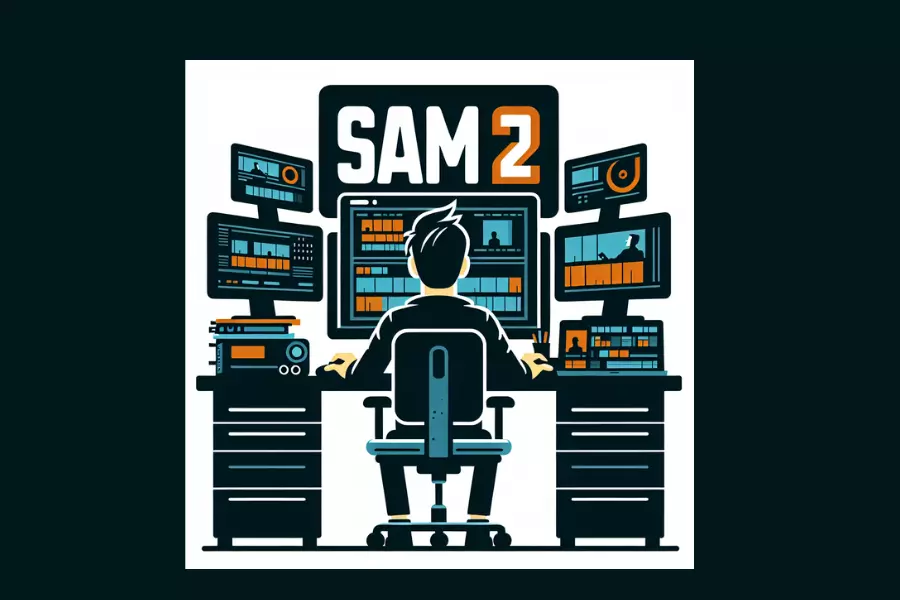Meta has introduced the new Segment Anything Model 2 (SAM 2) AI model, achieving real-time video object recognition and tracking, marking a major breakthrough in video AI technology. This article delves into SAM 2’s innovative features, applications, and its profound impact on the AI field.

Table of Contents
- Breakthrough Features of SAM 2
- Open Source Commitment and Resource Sharing
- Revolutionizing Video Editing
- Unified Image and Video Processing Model
- Wide Range of Applications
- Overcoming Video Segmentation Challenges
- Encouraging Community Exploration and Innovation
- Frequently Asked Questions
Breakthrough Features of SAM 2
SAM 2 is a significant upgrade from Meta’s image segmentation technology, specifically designed to address the unique challenges of video processing. This advanced model not only handles static images but also achieves real-time object recognition and tracking in dynamic videos.
Key features include:
- Real-time object tracking: Accurately identifies target objects even in fast-moving or occluded situations.
- Simple operation: Create high-quality object silhouettes with just a few clicks.
- Cross-frame processing: Maintains object recognition consistency across consecutive video frames.
Meta offers a free SAM 2 demo, allowing users to experience this revolutionary technology firsthand. You can try the demo version on Meta’s official website and witness SAM 2’s powerful features.
Open Source Commitment and Resource Sharing
In line with the principle of open science, Meta has decided to open source SAM 2 and release a large annotated video dataset used for training the model. This initiative reflects Meta’s commitment to promoting AI technology proliferation and innovation.
Open source content includes:
- Complete code and model weights of SAM 2
- SA-V dataset containing approximately 51,000 real-world videos
- Over 600,000 spatiotemporal masks (masklets) annotations
These resources will significantly boost the AI research community, driving advances in video processing technology. Researchers and developers can access these valuable resources from Meta’s GitHub repository.
Revolutionizing Video Editing
SAM 2’s real-time object tracking capabilities bring a revolutionary change to video editing. Complex editing tasks, such as object removal or replacement, can now be easily accomplished with a few clicks.
Application examples:
- Video background replacement: Easily separate characters from the original background and place them in a new scene.
- Object removal: Quickly identify and delete unwanted objects in the video, such as passersby or signs.
- Special effects addition: Accurately track specific objects and add animations or effects to them.
These features greatly simplify professional video production processes while providing powerful creative tools for ordinary users. More practical applications of SAM 2 in video editing can be found on Meta AI’s blog.
Unified Image and Video Processing Model
SAM 2 is the first unified model capable of processing both images and videos, a breakthrough that opens up new possibilities for multimedia content creation and analysis.
Key advantages:
- Cross-media consistency: Use the same model for both static images and dynamic videos, ensuring consistent results.
- Real-time performance: Achieves approximately 44 frames per second in video processing, providing a true real-time experience.
- Flexibility: Supports various input methods such as clicks, bounding boxes, or masks, adapting to different usage scenarios.
This unified processing capability brings new possibilities to fields like mixed reality (MR) applications, video editing software, and computer vision research.
Wide Range of Applications
SAM 2’s application range is extremely broad, playing a crucial role in industries from entertainment to scientific research.
Potential application fields:
- Film and television post-production: Precise object tracking and segmentation make special effects production more efficient.
- Medical image analysis: Helps doctors identify and track specific tissues or lesions in dynamic medical images.
- Autonomous driving: Enhances the real-time understanding capability of on-board systems for road environments.
- Ecological monitoring: Tracks and counts specific species in wildlife videos.
- Security systems: Enhances the intelligent analysis capabilities of surveillance cameras.
SAM 2’s flexibility and accuracy make it a powerful tool across various industries, driving technological innovation and efficiency improvements.
Overcoming Video Segmentation Challenges
Video segmentation faces more challenges compared to image segmentation, and SAM 2 successfully overcomes these difficulties through innovative design.
Major challenges and solutions:
- Fast object movement: Uses advanced tracking algorithms to maintain accurate positioning even during high-speed motion.
- Appearance changes: Adapts to appearance changes of objects in different frames using contextual information and temporal relationships.
- Occlusion handling: Introduces memory mechanisms to quickly re-identify objects after brief occlusions.
These technological breakthroughs enable SAM 2 to perform excellently in complex real-world scenarios, bringing a qualitative leap to the video processing field.
Encouraging Community Exploration and Innovation
Meta actively encourages the AI community to conduct in-depth research and innovative application development based on SAM 2.
Ways to participate:
- Download the model: Get the SAM 2 model from Meta’s provided download link.
- Use the dataset: Utilize the SA-V dataset for your own research and development.
- Try the demo: Experience the SAM 2 online demo to understand its features and potential.
- Share results: Share your innovative applications on social media using the #SAM2 hashtag.
Meta looks forward to seeing more breakthrough applications based on SAM 2, collectively advancing AI technology.
Frequently Asked Questions
-
Q: What are the main differences between SAM 2 and the original SAM?
A: The biggest advancement in SAM 2 is expanding segmentation capabilities from static images to dynamic videos, achieving real-time processing and cross-frame tracking.
-
Q: How long of a video can SAM 2 handle?
A: Theoretically, SAM 2 can handle videos of any length, but performance may slightly decrease as video length increases.
-
Q: How can ordinary users use SAM 2?
A: Meta provides an online demo for ordinary users to directly experience SAM 2’s features. More applications based on SAM 2 may be launched in the future.
-
Q: What is the open-source license for SAM 2?
A: SAM 2 is open-sourced under the Apache 2.0 license, allowing commercial use and modification.
-
Q: What specific applications does SAM 2 have in medical image analysis?
A: SAM 2 can help doctors track structures such as tumors and blood vessels in dynamic medical images like CT and MRI, improving diagnostic efficiency and accuracy.






